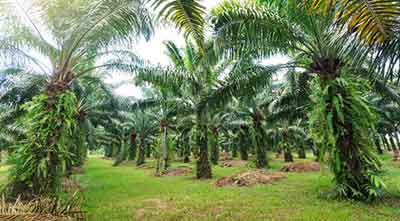Date: 13/02/2023
Relevance: GS-3: Agricultural produce and issues and related constraints
Key Phrases: Public Private Partnership (PPP) model, Traceability in the Supply Chain, National Mission on Edible Oils – Oil Palm (NMEO-OP), Freedom of Association and Collective Bargaining in India, Adequate Buffer Zones, Import Dependency
Why in News?
- The oil palm industry in India is based on a public-private partnership (PPP) model, involving over 99 percent of farmers, smallholders (SH), processing companies (millers), and the government.
- Farmers have a direct relationship with mills resulting in bargaining power but this is not the case in other parts of oil palm-growing countries.
- Palm oil millers in India are in a position to trace the source of each individual FFB (fresh fruit bunch) from SH, resulting in traceability in the supply chain but millers, on the other hand, in Malaysia are still unable to trace the source of individual FFB from SH.
Oil Palm Cultivation:
- Oil palm is a native of West Africa and popularly known as African oil palm or red oil palm.
- It is known to be the highest edible oil-yielding perennial crop.
- Palm oil has good consumer acceptance as a cooking medium because of its price advantage.
Distribution:
- It is grown extensively in South-East Asian countries, (Malaysia, Indonesia, and Papua New Guinea), African countries, (Nigeria, Ivory Coast, Ghana, Liberia, Sierra Leone, Cameroon, Republic of Congo, and Zaire), and South American countries (Costa Rica, Panama, Columbia, British Guyana, Peru, Ecuador, Venezuela, and Brazil). Malaysia, Indonesia, and Nigeria are the leading producers of oil palm.

Distribution in India:
- Andhra Pradesh, Telangana and Kerala are the main oil palm growing states, accounting for 98% of total production.
- Karnataka, Tamil Nadu, Odisha, Gujarat and Mizoram also have a sizable area under oil palm.
- Recently, Arunachal Pradesh, Assam, Manipur and Nagaland initiated large-scale planting programmes.
Climate requirements:
- Oil palm is a humid crop. Requires evenly distributed rainfall of 150mm/ month or 2500-4000mm/annum.
- Rainfall distribution in India is not even adequate. Hence oil palms are grown under assured irrigation conditions by adopting recommended practices.
- Crop comes up well between 29-33°C max. and 22-24°C min. temperatures and with bright sunlight for at least 5 hrs. per day.
- Humidity of more than 80% is required to come up well.
Import Dependency:
- India is the world’s largest importer of palm oil, buying over 9 million tonnes annually, or nearly two-thirds of its total edible oil imports.
- Most of the palm oil supply is imported from producing countries such as Indonesia, Malaysia, Colombia, and Thailand.
- However, the environmental impact of large-scale oil palm cultivation in these geographies is of concern globally as the regions continue to be associated with deforestation and peatland destruction for oil palm cultivation.
- In 2020, the import value of palm oil reached USD 5.12 billion.
National Mission On Edible Oils – Oil Palm (NMEO-OP):
- To counter India’s reliance on other palm oil-producing countries and to address the issue of non-employment among the vast Indian population, the Indian government launched the National Mission on Edible Oils – Oil Palm (NMEO-OP) in August 2021.
- The initiative aims to boost India’s self-sufficiency in edible oils and help increase farm incomes.
Freedom Of Association And Collective Bargaining By palm workers In India:
- SH and workers, without distinction, have the right to join or form trade unions or worker committees.
- There is a transparent and equitable mechanism in place for agreements in prices and price settings for the raw materials (FFB) supplied by them to the mills, where the government is involved in the process.
- There is no discrimination in hiring and employment practices, and equal treatment and no harassment of workers and their families are guaranteed.
Environmental Aspects Of Oil Palm Cultivation In India:
- India is the largest groundwater user and consumes around 4 per cent of total water resources, as per a World Bank report.
- In terms of the important water ecosystem, it is found in oil palm-growing States in India that adequate buffer zones are provided, largely driven by the government, for both lakes and major rivers and there is no link to oil palm farms.
- Scientific approaches like drip and micro irrigation practices by
the government are being adopted largely in the field of oil palm
across various States in India to ensure and monitor effective utilization
of groundwater resources and improve crop productivity as well.
- The SH farmers often lack the knowledge and skills to adopt better environmental and social practices and implement the system of production control required by companies with responsible sourcing of commitment.
What Needs To Be Done?
- Companies should develop awareness with the aim of generating a commitment to better practice, supporting the implementation of those commitments in practice, and working with the wider community to increase positive impact.
- Therefore, companies should look for ways to support SH inclusion more vigorously.
- At present, bio-mass utilization by palm oil mills in India is limited.
- Malaysia and Indonesia have developed value-added products through their in-house R&D, out of bio-mass, and also through the utilization of this bio-mass in various forms in their plantation estate, improving their crop productivity.
- The abundance availability of bio-mass in the mill should be converted to value-added products in India through R&D, which, in turn, will help to generate additional revenue for the mills.
Conclusion:
- Learning from other parts of the oil palm-growing world may be another approach through government-to-government dialogue, for which the Government of India should take initiative to engage closely with Malaysia and Indonesia with which we have a long trading relationship.
- Industry must build robust research capability to track the need and want of SH farmers, market dynamics, and drivers. This will enable millers to manage their profit margins.
Source: The Hindu BL
Mains Question:
Q. Evaluate the prospects and challenges of palm oil cultivation in India. (150 words).






















